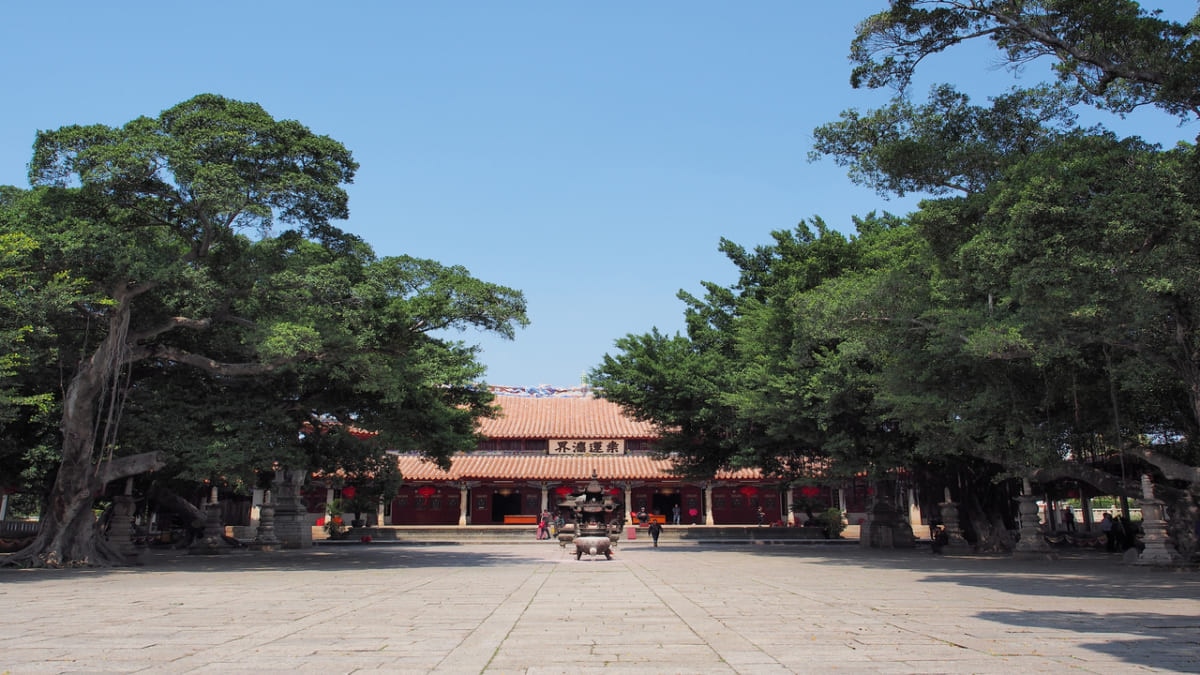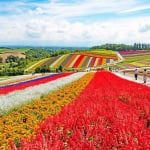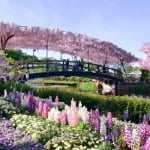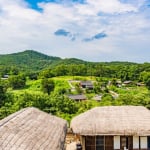Name: Kaiyuan Temple
Address: 176 West St, Licheng District, Quanzhou, Fujian Province, PRC 362000
Official/Related Website: http://www.qzdkys.com/

12 Must-See Tourist Spots in Quanzhou – Once the Starting Point of the Maritime Silk Road
12 Must-SeQuanzhou is a prefecture-level city located in the southeastern part of Fujian Province, China. As an ancient port town, its port in the northeastern area flourished during the Song and Yuan dynasties as the departure point of the "Maritime Silk Road." Even Marco Polo’s Il Milione praises the prosperity of Quanzhou.
From the Southern Song to the Yuan Dynasty, there was an extensive maritime trade route extending to Vietnam, India, and the Arabian Peninsula, known as the "Ceramic Road (Maritime Silk Road)," with Quanzhou serving as its starting point. Although the traces of its former status as a trading port are now scarce, many spots that reflect its past prosperity still remain and have become popular tourist attractions. Here, we introduce 12 must-see tourist spots in Quanzhou. Be sure to use this guide when planning your trip to Quanzhou!
table of contents
[x] close
12 Must-See Tourist Spots in Quanzhou – Once the Starting Point of the Maritime Silk Road
- 1. Kaiyuan Temple
- 2. Laojun Rock / Qingyuan Mountain Scenic Area
- 3. Quanzhou Maritime Museum (Haijiaoguan)
- 4. The Cai Family Ancient Residential Complex
- 5. Qingjing Temple
- 6. Quanzhou Islamic Sacred Tomb
- 7. Chongwu Ancient City
- 8. Tianhou Temple
- 9. Tonghuai Guanyue Temple
- 10. Fumi Palace
- 11. China-Mindai Edge Museum
- 12. Luoyang Bridge
- ◎ Summary
1. Kaiyuan Temple
Kaiyuan Temple is the largest Buddhist temple in Fujian Province, located in the northwestern part of Quanzhou. Designated as a nationally important cultural property, it is one of Quanzhou’s most famous attractions and is visited by nearly every tourist who comes to the city.
Originally established in the 26th year of Kaiyuan (738 AD) by imperial decree of Emperor Xuanzong of the Tang Dynasty as an official temple set up in various provinces, Kaiyuan Temple boasts the largest grounds in Fujian. Intricate sculptures based on ancient Indian mythology adorn many parts of the temple. Highlights include the 48-meter tall Eastern Pagoda "Zhenguo Pagoda" and the 44-meter tall Western Pagoda "Renshou Pagoda," which together form the iconic "Twin Pagodas" that have become a symbol of the local overseas Chinese community in Quanzhou. In addition, the Hongyi Master Memorial Hall at Zunshengyuan within the temple complex is also well worth a visit.
2. Laojun Rock / Qingyuan Mountain Scenic Area
Laojun Rock is a gigantic rock located in the northern outskirts of Quanzhou in Fujian Province, engraved with the image of the Supreme Daoist – Laozi. Originally known as Xianyan, it later came to be called Laojun Rock due to its resemblance to an old man.
Regarded as the largest Taoist stone statue of Laozi in China, Laojun Rock vividly depicts the benevolence and calm expression of the elderly sage, symbolizing health and longevity. A well-known local legend says that touching Laozi’s nose will grant one a lifespan of 120 years.
Qingyuan Mountain, where Laojun Rock is situated, forms part of the Qingyuan Mountain Scenic Area—a state-level key scenic area filled with unique rock formations and caves. This historical landscape is one of Quanzhou’s most popular attractions and is best visited together with Laojun Rock.
Name: Laojun Rock / Qingyuan Mountain Scenic Area
Address: Qingyuan Mountain, Tongzawa District, Quanzhou, Fujian Province, PRC
Official/Related Website: http://www.qingyuanmount.com/index.asp
3. Quanzhou Maritime Museum (Haijiaoguan)
The Quanzhou Maritime Museum, also known as Haijiaoguan, is the only maritime museum in China still in existence. The museum consists of two parts—a new building and an old building—both located within Quanzhou, where exhibits document the history of its trading port.
The old museum, situated on the east side of Kaiyuan Temple’s grounds, features a Song Dynasty shipwreck discovered in Quanzhou Bay in 1974. The new museum, located in the eastern suburbs of Quanzhou, displays maritime artifacts as well as tombstones and stone carvings from the Song and Yuan dynasties onward, related to Islam, Hinduism, and Manichaeism. This museum is always bustling with visitors.
Name: Quanzhou Maritime Museum (Haijiaoguan)
Address: 25 Donghu St, Fengze District, Quanzhou, Fujian Province, PRC 362000
Official/Related Website: http://www.fujian.gov.cn/ggfwpt/gysy/wtxx/wtfwzyk/bwg/201109/t20110926_395132.htm
4. The Cai Family Ancient Residential Complex
Located in the "Xiaogan" area on West Street in Quanzhou, the Cai Family Ancient Residential Complex is a collection of traditional houses. The former residence of the famous Ming Dynasty neo-Confucian scholar Cai Qing, which dates back 500 years, is part of this complex. The red-brick, single-story longhouses display intricate architectural details at the entrance and eaves, and their unique appearance has made them a popular attraction for tourists. When visiting Quanzhou, be sure to take a detour to see this distinctive heritage site.
Name: Cai Family Ancient Residential Complex
Address: Jinjiang, Quanzhou, Fujian Province, PRC
5. Qingjing Temple
Qingjing Temple, located in the southern part of Quanzhou’s urban area, is the oldest Islamic temple in China. Known as Aisuha Zi Dasi as well, Qingjing Temple is one of China’s representative examples of Islamic architecture. It is said to have been modeled after an Islamic prayer hall in Damascus, Syria, and is one of Quanzhou’s most popular attractions.
The Arab-Islamic architectural style, adopted from West Asia, has been designated as a national key cultural relic. Highlights include a three-story arched main gate measuring approximately 20 meters in height and 45 meters in width, constructed from huangyan stone and white marble dating back to the early 11th century. Other notable features include the Fengtian Altar on the west side of the gate tower and the stone stele of the Zhusheng Pavilion on the east side. With its rich international flavor unique to the ancient trading port of Quanzhou, Qingjing Temple is a must-visit spot.
Name: Qingjing Temple
Address: 108 Tumen St, Licheng District, Quanzhou, Fujian Province, PRC 362000
6. Quanzhou Islamic Sacred Tomb
The Quanzhou Islamic Sacred Tomb, also known as the Ling Mountain Islamic Sacred Tomb, is part of the Chen Jiangding Clan Ancestor Tomb Group. Located at the foot of Qingyuan Mountain in the Qingyuan Mountain Scenic Area—a nationally key scenic spot—it is one of the best-preserved Islamic sites in China and is recognized as an important cultural relic.
The tomb group, featuring a series of Islamic graves, is the highlight, with many visitors focusing on the Ling Mountain Sacred Tomb located in the western corridor. Two Islamic tombs, constructed of granite, are elegantly integrated into the beautiful landscape. If you visit Quanzhou, this is a must-see attraction.
Name: Quanzhou Islamic Sacred Tomb
Address: Fengze District, Quanzhou, Fujian Province, PRC 362000
7. Chongwu Ancient City
Chongwu Ancient City is located at the tip of the Chongwu Peninsula on the southeastern coast of Hui'an County, Quanzhou, facing the Taiwan Strait. This fortified city, built in a T-shape as a defense against pirates, is the only one in China that still retains its original coastal appearance. It is an important historical site for the study of Chinese fortifications.
Constructed entirely of granite, the city walls span four hills. Inside the walls, an old town (lao jie) has developed, where unique local customs—such as those practiced by the famously beautiful "Hui'an Women"—can be observed. The small ethnic district dedicated to the Hui'an Women is a notable tourist highlight.
Name: Chongwu Ancient City
Address: Chongwu Town, Hui'an, Quanzhou, Fujian Province, PRC
8. Tianhou Temple
Located on Tianhou Road in the urban area of Quanzhou, Tianhou Temple, also known as Tianfegong, is the oldest, largest, and most prestigious Mazu (sea goddess) temple in China. It has been designated as a nationally important protected cultural relic and is a key attraction in Quanzhou.
Mazu temples are dedicated to the goddess of maritime safety. Mazu, originally known as Lin Mo-niang—a local woman from Meizhou Island during the Northern Song Dynasty—gained the ability to traverse the seas and save fishermen from shipwrecks, and ascended to heaven at the age of 27. She was later elevated to the title of Tianhou (Empress of Heaven) by the Qing emperors Kangxi and Qianlong, and her temple in Quanzhou is considered the original Mazu temple. Even today, local fishermen make it a point to visit Tianhou Temple before setting sail. It is an immensely popular attraction for those touring Quanzhou.
Name: Tianhou Temple
Address: 1 Tianhou Rd, Licheng District, Quanzhou, Fujian Province, PRC 362000
Official/Related Website: http://www.qzthg.com/
9. Tonghuai Guanyue Temple
Tonghuai Guanyue Temple is a temple dedicated to Guan Yu, located about 100 meters from Qingjing Temple in central Quanzhou. Originally established to honor Guan Yu (also known as Guan Di), it was later renamed Guanyue Temple as the tragic hero and general Yue Fei of the Southern Song was also enshrined here. The temple houses many stone steles from the Qing Dynasty, making it a must-see attraction for fans of the Romance of the Three Kingdoms. The interior of the temple is often crowded with worshippers—sometimes even more than tourists. When visiting Quanzhou, be sure to add this spot to your itinerary!
Name: Tonghuai Guanyue Temple
Address: 196 Tumen St, Licheng District, Quanzhou, Fujian Province, PRC 362000
10. Fumi Palace
Fumi Palace is a royal temple (ancestral worship temple) located in Fumi Village on Shuixiang Alley near the South Gate of the Licheng District in Quanzhou. Founded during the Zhengde period of the Ming Dynasty (1505–1521), Fumi Palace served as the main temple for welcoming royal envoys. All royal envoys arriving in Quanzhou were said to pay their respects here. Royal deities were revered as gods who could ward off epidemics, and it was believed that by placing a royal deity’s statue on a boat and sending it out to sea, the deity would carry the epidemic away. Fumi Palace displays a replica boat offered in honor of the deity—a highlight of the attraction.
Name: Fumi Palace
Address: Wanshou Road, Licheng District, Quanzhou, Fujian Province, PRC
11. China-Mindai Edge Museum
The China-Mindai Edge Museum is a national-level museum in Fujian Province dedicated to the history of exchanges with Taiwan and the culture of Taiwan. The building’s unique design and surprisingly large scale make it stand out. The name “Min” refers to the ancient name of Fujian Province, and “Tai” refers to Taiwan. This museum presents the enduring bond between Fujian and Taiwan from ancient times to the present. In addition to exhibits on the relationship between Fujian and Taiwan, the museum displays archaeological finds from the Stone Age and materials related to Japan’s invasion of Taiwan. Touring this museum along with the Maritime Museum can deepen your understanding of Quanzhou’s history.
Name: China-Mindai Edge Museum
Address: Huanqu Rd, Chengbei Road, Fengze District, Quanzhou, Fujian Province, PRC
Official/Related Website: http://www.mtybwg.org.cn/
12. Luoyang Bridge
Luoyang Bridge spans the Luoyang River, connecting Hui'an County to Quanzhou City, and is located about 10 km east of Quanzhou’s Licheng District. Also known historically as Wan'an Bridge, this granite bridge was a vital transportation and logistics hub, and its beautiful views remain popular with tourists.
Completed in 1059 during the Song Dynasty, Luoyang Bridge is 834 meters long and 7 meters wide, with 31 piers. Built over a river mouth where the waves are rough, it was constructed using unique engineering methods. The beauty of Luoyang Bridge has been celebrated in the works of famous poets and writers from the Song Dynasty, making it a truly scenic and breathtaking spot. Be sure to extend your tour to visit this spectacular bridge!
Name: Luoyang Bridge
Address: Wan'an Rd, Luojiang District, Quanzhou, Fujian Province, PRC
◎ Summary
We have introduced 12 tourist spots in Quanzhou. How did you like them? In addition to its rich array of attractions, Quanzhou is a thriving industrial city famous for producing Oolong tea from Anxi County (one of China’s top tea-producing areas), shoes and stone materials from Jinjiang (one of China’s three major footwear production areas), porcelain from Dehua County (one of China’s three major porcelain production areas), and vinegar from Yongchun County (one of China’s four famous vinegars). During your tour, you can also pick up souvenirs like Oolong tea or fine porcelain, making your trip even more memorable.
RELATED ARTICLES
REGIONS
CATEGORIES
FEATURED ON Guide
-

Where will you go for the summer vacation? Introducing recommended spots for domestic travel
-

Kaizu City’s Recommended 7 Tourist Spots. Enjoy the Culture and History Nurtured by Wajū!
-

What Makes Ashikaga Flower Park So Special? A Treasure Trove of Photo-Worthy Spots!
-

600 Years of Radiant Tradition: Korea’s Historic Villages of Hahoe and Yangdong
-

Two-Colored Seas and a Pink Beach! 4 Must-Visit Spots in North Eleuthera
MOST POPULAR ON Guide
-
 1
1Doha: Must-see Attractions in the Capital of Qatar
-
 2
2Toronto: 10 Things to do in this Picturesque Canadian City
-
 3
3Amarillo: A City Famous for It’s Amazing Canyons, Great History and Music
-
 4
4South Korea: Dazzling Scenery, Rich Culture and Fascinating History
-
 5
5Kuwait: A Country in Middle East Asia Famous for Hot Sand Dunes and Stunning Cityscape





